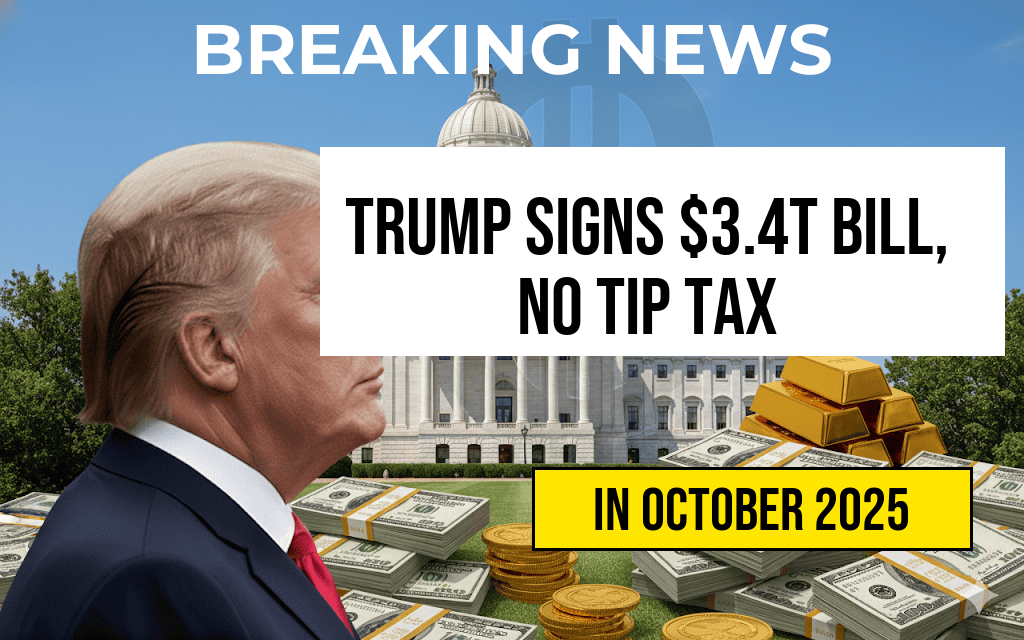Trump Signs $3.4 Trillion Mega-Bill Amid $4 Trillion Debt Surge, Vows No Tax on Tips
Former President Donald Trump has signed a sweeping $3.4 trillion legislative package that significantly expands federal spending while simultaneously increasing the national debt by approximately $4 trillion. The legislation, passed narrowly through Congress, aims to fund a wide array of programs including infrastructure, defense, and social services, but has ignited debate over its fiscal impact. Notably, Trump emphasized a provision promising that workers will not face new taxes on tips, seeking to assuage concerns from hospitality industry advocates and workers. The bill marks one of the most substantial financial commitments in recent U.S. legislative history, reflecting a bipartisan push for expansive government spending despite growing concerns over long-term debt sustainability.
Key Highlights of the Legislation
Massive Spending and Debt Implications
- The bill allocates $3.4 trillion for federal programs over the upcoming fiscal year, covering a broad spectrum from infrastructure to healthcare.
- The legislation increases the national debt by roughly $4 trillion, bringing total U.S. debt past the $34 trillion mark, according to Treasury Department estimates.
- This level of borrowing represents one of the largest debt increases in recent history, raising concerns among fiscal conservatives about future economic stability.
Major Policy Provisions
- Infrastructure Investment: Allocates significant funding toward roads, bridges, and public transit projects, aiming to bolster economic growth.
- Social Programs: Expands funding for education, child care, and health services, emphasizing support for vulnerable populations.
- Defense Spending: Maintains or slightly increases military budgets, aligning with longstanding priorities.
- Taxation and Revenue: Features no new taxes on tips, a key promise made by Trump, and maintains current tax rates for most Americans.
Vow to Protect Tip Income Sparks Industry Support
One of the most prominent features of the bill is the explicit promise that workers in the hospitality sector will not face new taxes on tips. Trump highlighted this aspect during the signing ceremony, stating, “We are ensuring that hardworking Americans, especially those earning tips, are protected from any new tax burdens.” This reassurance has been welcomed by restaurant owners and service industry employees concerned about potential tax hikes that could diminish take-home pay.
Tax experts note that tips have historically been a contentious issue in federal taxation, with debates over how to fairly regulate and tax tip income without discouraging service employment. The legislation’s stance aims to maintain current policy, avoiding complications for workers and employers alike.
Political Reactions and Fiscal Debate
Supporters Cite Economic Stimulus Goals
- Lawmakers from both parties emphasize the bill’s potential to jumpstart economic recovery following recent downturns.
- Proponents argue that aggressive investment in infrastructure and social programs will create jobs and promote long-term growth.
Critics Warn of Long-Term Debt Risks
- Opposition voices warn that the $4 trillion increase in debt could exacerbate inflationary pressures and burden future generations.
- Fiscal watchdogs question whether the bill’s spending will deliver proportional economic benefits, warning of unsustainable deficits.
Economic Context and Future Outlook
| Aspect | Amount |
|---|---|
| Total Bill Spending | $3.4 trillion |
| Estimated Debt Increase | $4 trillion |
| Projected Debt Post-Legislation | Over $34 trillion |
Experts suggest that while the immediate economic stimulus could provide short-term benefits, the long-term fiscal health will depend on subsequent policy decisions and economic growth trajectories. Analysts at institutions like the Congressional Budget Office (CBO) highlight the importance of balancing fiscal expansion with sustainable debt management, pointing to potential risks if borrowing continues at this pace.
For more on the current U.S. debt situation, see [Wikipedia’s U.S. Debt](https://en.wikipedia.org/wiki/National_debt_of_the_United_States) and [Forbes’ analysis on fiscal policy](https://www.forbes.com/sites/forbesfinancecouncil/2023/03/10/understanding-the-impact-of-high-debt-on-the-economy/).
Public Response and Next Steps
Public reactions have been mixed, with some praising the bill for its ambitious scope and others voicing concern over its long-term fiscal implications. The legislation is now set to be implemented over the coming months, with agencies beginning disbursement of funds and oversight measures to ensure transparency.
As the debate over government spending and debt continues, the legislation underscores the ongoing challenge of balancing economic growth initiatives with prudent fiscal management. The promise to safeguard tip income remains a notable point of consensus among supporters, reflecting the bill’s broader aim to support working Americans while pursuing expansive policy goals.
Frequently Asked Questions
What is the total value of the mega-bill signed by President Trump?
The mega-bill signed by President Trump is valued at $3.4 trillion.
How much will the national debt increase as a result of this bill?
The debt is expected to increase by approximately $4 trillion due to this legislation.
Does the bill include any provisions related to taxing tips?
According to President Trump, the bill includes a promise of no tax on tips.
What are the main components or purposes of this mega-bill?
The mega-bill covers a wide range of spending and policy measures, aiming to address economic needs and fund various government programs.
What has been the reaction to the signing of this large legislative package?
Reactions vary, with some praising the economic stimulus and tax assurances, while others express concerns about the debt increase and long-term fiscal impact.

Leave a Reply